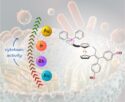Dr. Saskia Neubacher and Dr. David Peralta, Editors for ChemistryOpen, talk to Professor Berit Olofsson, Stockholm University, Sweden, about her article on metal-free arylations that was published in ChemistryOpen.
The paper describes an easy way of synthesizing alkyl aryl ethers without the need for transition metals, high temperatures, or toxic reagents. This is especially important for the pharmaceutical industry, where trace amounts of remaining metal in products must be avoided.
What was the inspiration behind this study?
Our research in metal-free arylations with diaryliodonium salts has been of interest to the pharmaceutical industry, as they often have problems with functional group compatibility with metal-catalyzed arylation methods. When we reported the facile, room-temperature arylation of phenols [1], researchers at AstraZeneca highlighted the need for a metal-free arylation methodology of aliphatic alcohols.
The general aim is to develop metal-free reactions as efficient alternatives to reactions normally performed by transition-metal catalysis. The drawbacks associated with the latter area serves as inspiration, especially considering the growing awareness of environmental aspects and limited resources of transitions metals.
What benefits do transition-metal-free transformations have?
Transition-metal-free reactions are often practical, as they are generally less sensitive to air and moisture. Furthermore, transition metals are associated with drawbacks such as cost, toxicity, need for non-commercial ligands and threshold values in pharmaceutical products.
Is your research group involved in any other projects?
This investigation belongs to an ongoing program in our lab, which is focused on metal-free arylations of heteroatom nucleophiles. We have recently developed a methodology for the O-arylation of a range of oxygen nucleophiles, with important features such as room temperature reactions, short reaction times, good functional group compatibility, and avoiding toxic reagents.
Roughly how long did it take to conduct the research reported in this paper? What are the next steps you plan to take in this project?
The project was conducted in parallel with the metal-free arylation of activated alcohols in water [2]. Together, the two interlinked projects took about one and a half years, mainly due to some unexpected difficulties that we did not encounter in previous O-arylations. We are currently performing mechanistic studies of the reaction to understand these difficulties, and find solutions that increase the scope further.
What is your longer-term vision for your research?
Research in hypervalent iodine chemistry has increased tremendously the last decades, and the reactivity and low toxicity of these reagents are ideal for development of a wide variety of transformations.
To increase the atom efficiency of reactions with hypervalent iodine reagents, and iodonium salts in particular, the long term goal is to find catalytic reaction conditions instead of using stoichiometric amounts of iodonium salts.
The article they talked about
- Room Temperature, Metal-Free Arylation of Aliphatic Alcohols,
Raju Ghosh, Erik Lindstedt, Nazli Jalalian, Berit Olofsson,
ChemistryOpen 2014, 2, 54–57.
DOI: 10.1002/open.201402006
References
- [1] Room Temperature, Metal-Free Synthesis of Diaryl Ethers with Use of Diaryliodonium Salts, Nazli Jalalian, Eloisa E. Ishikawa, Luiz F. Silva, Jr., Berit Olofsson, Org. Lett. 2011, 13, 1552–1555. DOI: 10.1021/ol200265t
- [2] Metal-Free Synthesis of Aryl Ethers in Water, Erik Lindstedt, Raju Ghosh, Berit Olofsson, Org. Lett. 2013, 15, 6070–6073. DOI: 10.1021/ol402960f




